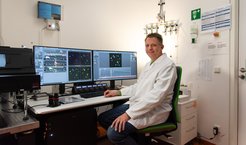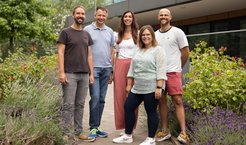Temperature, vibration and more: Optimal planning of core facilities
Christian Kukat on his latest publication, his favourite instruments and the fascinating microscopes at the FACS & Imaging Core Facility
Dr Christian Kukat is head of the FACS & Imaging Core Facility at the Max Planck Institute for Biology of Ageing. Together with his colleague Dr Hans Fried, head of the Light Microscopy Core Facility at the German Centre for Neurodegenerative Diseases (DZNE) in Bonn, he has now published a paper on how to optimally plan a new core facility, what special technical requirements are needed and what influence it has whether you build a new facility or move into existing premises. We spoke to Christian not only about the new publication, but also about his career and his favourite equipment in the facility.

Christian, how did this publication come about?
Together with my good colleague Dr Hans Fried from the DZNE, I presented a poster at a microscopy conference on how best to set up an imaging core facility. We moved our Imaging Core Facility into existing premises 10 years ago. However, new buildings were being built at the DZNE, so the new core facility could be planned from scratch and we had much more influence. In the poster session we presented what is important when building a facility, both in existing premises and in a new building. And that was a really stressful poster session because there was so much interest and we were literally besieged at the poster.
What happened next?
We then realised that this is really something that affects almost all core facilities - the technical requirements are often very similar, whether you are setting up microscopes or mass spectrometers, and it is something that a lot of people are interested in. So we decided to publish our ideas and plans. We also set ourselves the task of approaching the subject scientifically, rather than just telling anecdotal stories, as is often the case in previous publications on the subject. That's why we started collecting data, for example long-term temperature data.
What have you learned from this, what are the key technical requirements?
The ambient temperature is indeed a big issue. Temperature stability affects the experiments, it's crucial for a mass spectrometer, a microscope and also a cytometer or sorter. Vibrations also play a big role, especially with microscopes. These are sometimes small details: We once had the problem of a heavy door slamming two rooms away and then there were too many vibrations for the microscope images.
Is there anything that was technically more difficult to implement for the FACS & Imaging Core Facility because you moved into a building that was already completed?
For example, we can't control the ventilation as precisely because we are connected to the building's ventilation system. We can't just turn the cooling down completely because that would affect the rooms around us, or the cooling capacity wouldn't be sufficient. Of course, it's easier to design from the ground up, and we've had to be a bit more creative with our spaces. For example, we started to extract heat directly from certain heat sources. Sometimes it's about smaller effects.
You were previously a postdoc in the lab and published there. Was it different for you to write this publication now?
I found it much harder. There were hardly any publications in this direction and the research question was less defined. The challenge was to present the technical details well and make them understandable. Finding a journal was not easy either. We needed a journal that had the right focus, i.e. the right readership that was affected by and interested in these topics. Cytometry Part A has a category for articles from core facilities, and this was a good fit for us and the topic.
How did you go from being a scientist to running a core facility and how did you acquire the necessary skills?
I was a postdoc in Prof Nils-Göran Larsson's group and had already operated a lot of microscopes and taught others. I always enjoyed it. When I became head of the FACS & Imaging Core Facility, I acquired knowledge from many different sources: I went to conferences, took courses, such as a Core Facility Management course, and a lot of it was through networking and personal exchanges.
How exciting! How has Facility evolved from its beginnings to the present day?

Finding the right people was very important. It is very important to have a well-functioning team and to be able to work well with different people, even as the head of the core facility. You can be as good as you are professionally, but if you can't deal and communicate with the different groups, such as the researchers, the administration, the companies and your own team, it won't help you. We have gone from a handful of instruments to 50 instruments that we can offer to users. All this is only possible because I have such a great team - everyone is really good, does an excellent job and is highly motivated.
Do you have a favourite among the 50 instruments in your pool?
I really like the classic laser scanning confocal microscopes because I have done a lot of work with them and they are very flexible and can be used for a lot of different experiments. What I also think is really cool and proud of is the super-resolution STED microscope. It opens up another window and you can see even smaller structures and I always find it fascinating what you can do with it.
What are your goals for the next few years?
We are celebrating our tenth anniversary next year and I am very proud of that. We want to continue to provide the best possible service and training for our users. We simply want to enable the best research.













